As the Native Americans and early settlers knew, if you find cattails you have 4 of the 5 things you need life.
You have the water in which they grow to drink (probably best to boil it for a while of course), you can eat them as food, burn them to make a fire, and weave them to make a structure to sleep under.
Cattails, which are from the scientific genus of Typha, have been used for hundreds of years for all these purposes. Nutrition-wise they are rich in vitamins A, B, and C, and are filled with potassium and phosphorus.
They produce more starch per acre than any other plant known, more than, rice, yams, and even potatoes.
But for reasons that are quite unclear to me they are not as commonly cultivated or harvested as they should be. If you think of the cattail as a huge spring onion, that gives you all the uses you can put it towards.
Related: 50+ Survival Uses For Cattails
If you are feeling a bit peckish while out fishing or on a hike with a stream nearby it is likely that you can find cattails at the water’s edge.
Harvesting
There are two main varieties in the United States, Typhus latifolia and Tyhpus angustifolia and either one is good eating. In a pinch, all you really have to do is pull them up, wash them off, and take a bite.
The most tender parts are usually in the ground or just above it so make sure when you are pulling out them out that you get all the way down to the rhizomes (their roots) or as close as you can.
If you plan on taking them home, you can leave the top two-thirds behind at the river’s edge as it is usually too tough and fibrous.
Once home, wash them off again, cut off the bottom most root system and just above the where it starts to go green or brown.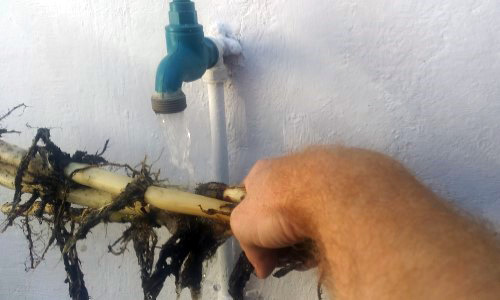
Make you sure you check in the top part of your stalk for Arrowhead beetle grubs as they like to hide out there.
You could eat them apparently, but I never have. Fish love them so they are good for bait, however.
Depending on the size of your cattail, you should have at least 5 or 6 inches of good stuff left. Then strip off the outer couple layers, it should peal just like a leak, or spring onion, until you get to the more tender inner core.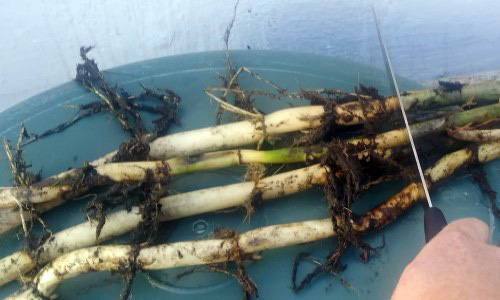
With your cattail thusly prepared you can now cook with it in any number of dishes.
Chop it up and add it to soups just like you would a leek or use it as a garnish on top of potatoes. You can even use it in a stir fry cut into longer thin pieces.
If you are looking to store your cattail for longer than a week or two in the refrigerator, one of my favorite ways of preserving them is by pickling them just like you would cucumbers or onions.
Preserving
Below I am going to share with you my recipe; but really any pickling concoction you like to use will work just fine. If you like chilli, add it, if you want to substitute white wine for the sugar, then you are more than welcome, just reduce the amount of vinegar.
As always, the most important part to canning pickled vegetables is to make sure your jar is sterile before putting in your ingredients.
As far as how long to leave your cattails to pickle, I find one month to be the minimum time necessary for your pickling liquid to really infuse into the cattails, but two months is better. When they are ready, eat them just like you would a pickled cucumber or onion, straight from the jar.
What You Will Need
The ingredients for this recipe are easily found at your neighborhood grocery store.
Foraging for cattails is the fun part. Cattails bloom in March through May and have that very distinctive “cattail” flower so if you are unsure what a cattail looks like it is probably best to go foraging for them when they are easiest to identify.
Related: 16 Wild Edibles You Didn’t Know You Could Forage For
There are a couple water grasses that look similar to a cattail when they aren’t flowering and which are decidedly NOT good eating, so if you are foraging out of their flowering season make sure you know what you are picking.
Cattails don’t have a strong smell, so if the thing you are picking is pungent, it probably isn’t a cattail.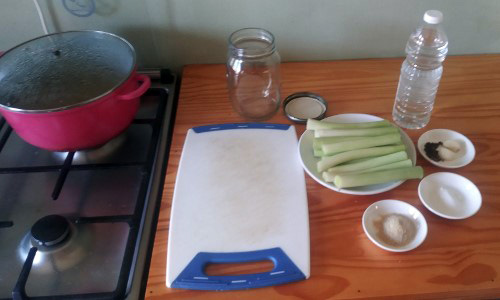
- Cattails (the amount really depends on how much you want to pickle. I find four or five good size stalks plenty to fill a mason jar)
- 2 tablespoons sugar (I like brown sugar but you can use white just as well)
- 1 tablespoon salt
- 1 teaspoon black peppercorns
- 2 large cloves of garlic peeled
- White spirit vinegar (enough to fill the mason jar once full of cattail.
- A mason jar
- A knife
- A pot to sterilize your jar
Preparing Your Cattails
1. As explained above, clean, trim, and peel your cattails and then cut them into pieces short enough that they will fit into a mason jar.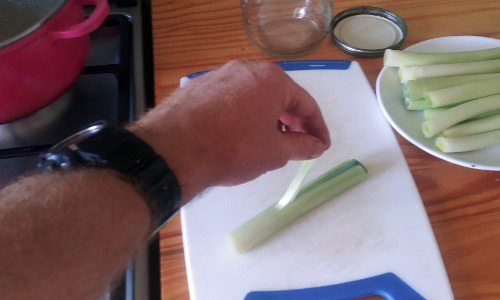
2. Sterilize your jar. Get some water up to a rolling boil. Ad your mason jar and then cover the pot and leave it in after it returns to a roiling boil for at least 10 minutes.
Then take it out of the water carefully with a pair of tongs.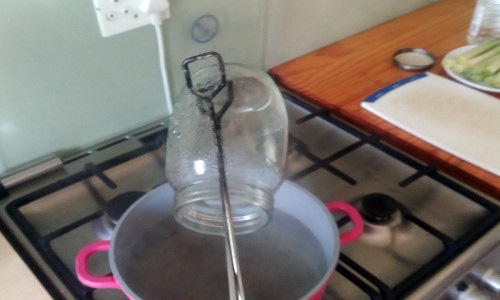
3. Add the pickling spices to the jar.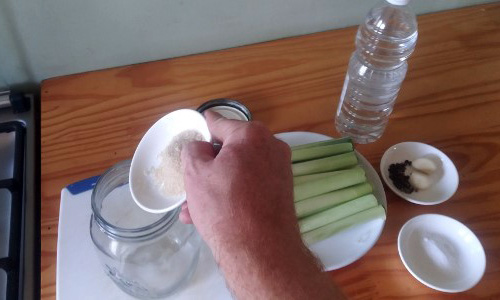
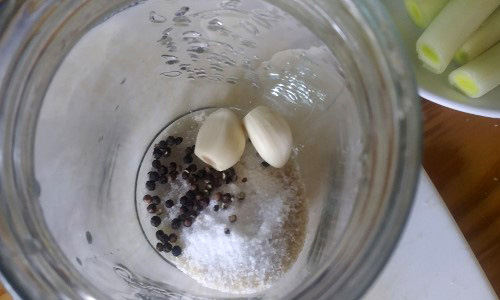
4. Then add your prepared cattails. Push them in quite tight.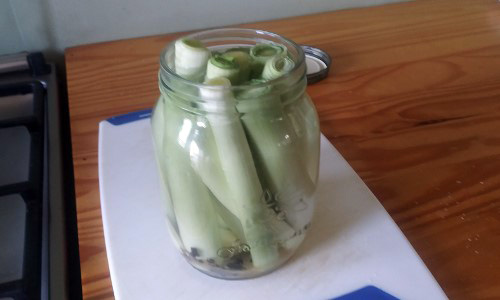
5. Last pour in your white spirit vinegar cap it tightly.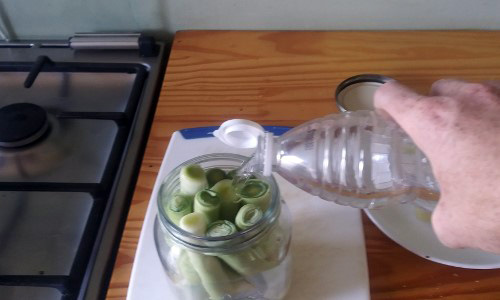
6. Tip it upside down and shake it a few times so that the pickling spices dissolve easily. Then return the filled mason jar to your water bath pot and let it boil for another 10 minutes.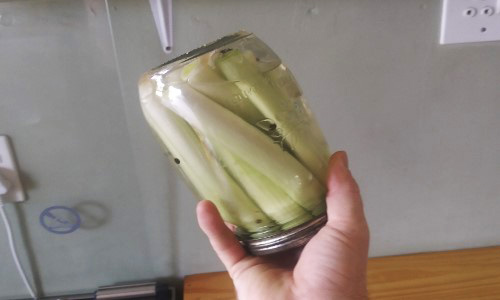
7. That’s it! With a little patience you will have some crisp and refreshing pickled cattails to eat.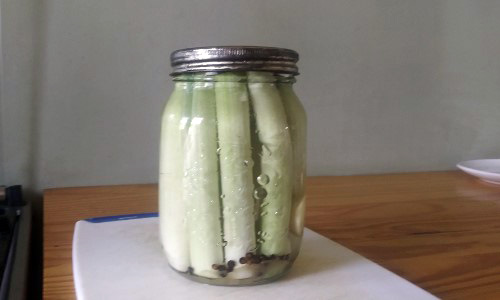
Storage
Like most canned foods it is best to store your pickled cattails in a cooler location that doesn’t experience big temperature fluctuations like a cellar or basement.
Don’t, however put the jars that you have taken fresh from the boiling water bath directly into a refrigerator to cool. Let them cool slowly at room temperature.
You will know the canning process has worked if you can’t push down the “button” on the can lid. If it the button does depress, don’t worry you can either repeat the process or just pop them in the refrigerator after they have cooled down.
The pickling brine, because it is so acidic, is itself quite good at preserving its contents and keeping nasty bacteria at bay. In the refrigerator your pickled cattails will last at least 6 months.
On the other hand if your canning efforts were successful you can easily store your pickled cattails for a couple of years in your cellar.
Once you’ve opened them either eat them within a couple of weeks or store them the refrigerator.
Happy pickling!
You may also like:
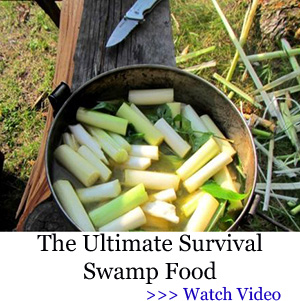 How To Make Your Own Salt For SHTF
How To Make Your Own Salt For SHTF
10 Deadly Canning Mistakes You Need To Stop Making Right Now (Video)
Debunking Expiration Dates – What You Need to Know

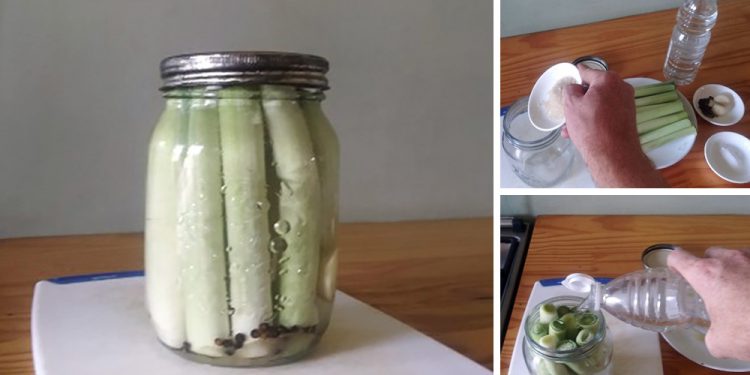




















What a really Great article! One of the best so far this year! Hits all my high notes! Love to make something out of nothing. Love to make something tasty to feast on. Love it when something is universal or multi purpose! And widely available in a pinch if you know what to look for! Cattails – Not just for Fall Decor anymore!
This is cool, thank you! It temps me to move back to the swamps of Penna just so I can make these and enjoy cattails, again. Pollen, good stuff, too. It ranked up there with maize pollen in religious ceremonies, which shows how much people loved cattails. niio
Yea that’s disgusting
Pickled cattails? Sounds awful. Pass me a jar. 🙂
I didn’t have a clue what white spirit vinegar was. I have never heard of white vinegar being described as anything other than just plain old white vinegar, so I went on line to find out what white spirit vinegar was. I will post below what I found on a website called “Supreme Vinegar.” Inasmuch as I didn’t know what the substance was that I was searching for, I can’t attest to the accuracy of what I will post below. I will just comment that the author whomever it may be seems to know a whole lot more about vinegar than I.
“What is white distilled vinegar?? There are a lot of myths and misconceptions about what white distilled vinegar is, what it means to have “organic” white distilled vinegar, etc. Here I will try to explain in detail and clear up any misconceptions.
“First, a bit of history. White distilled vinegar, known outside the US and UK as “spirit vinegar” or “alcohol vinegar”, originated around the 1860s, most likely in Germany. With the advent of a new manufacturing process (the quick process) for vinegar that allowed it to be industrialized, options expanded beyond the traditional slow fermented vinegar from grape wine or hard cider. What was discovered was that distilled spirits, from the cheapest source possible, could make a relatively bland vinegar that could be used for basic uses, cleaning, sauces, and importantly, for the new industries of pickling and canning.
“Spirit vinegar used basically whatever was cheaper in the country where it was made. The Germans used alcohol from fermented potatoes, aka watered down vodka. The French used sugar beets, the British used low quality malt vinegar, the Kiwis in New Zealand settled on milk whey, and in the USA, spirit vinegar was made from alcohol distilled from fermented molasses. That is why we Americans call White vinegar “distilled”. In short, these gave you nearly pure ethanol and this was made into cheap vinegar. In the process it destroyed much of the traditional vinegar makers, particularly in Europe where the city of Orléans went from about 200 traditional wine vinegar makers to 17 in a 100 year period up to World War I. Granted, other economic and political realities were at play here but spirit vinegar was the knockout punch.
“As I stated before, the distillation of fermented molasses into a relatively clear alcohol called “low wine” is why Americans call spirit vinegar “distilled vinegar”. However, nowadays white distilled vinegar is not distilled in any part of its process. What happened in the post World War II period was the introduction of cheap ethanol made directly from ethylene that could be extracted from natural gas. This process, known as the Wacker Process, gave the vinegar industry ethanol cheaper than they could get from molasses and without the expensive distillation equipment that one would need. From this point on, white distilled vinegar, at least in the USA, would be made directly from ethanol.
“US FDA regulations require any vinegar for human consumption has to be fermented naturally, by bacteria, so synthetic acetic acid was never used for white vinegar (legally). This is not the case in countries like Russia or India where industrially produced acetic acid using non-biological reactions can be sold as vinegar. However, the ethanol can come from any source as long as it is not tainted and is fermented naturally to white distilled vinegar. As manufacturers we also are not mandated to disclose the source of the ethanol.
“Pure ethanol does not have enough nutrients for the bacteria to thrive so nutrients, such as phosphates or yeast extract, are added to get the fermentation going. As time went on, different sources of ethanol became available that allowed one to juggle your options to find the cheapest source to use. Ethylene was a favorite source but at times corn ethanol or sugar cane ethanol from Brazil have been cheaper options to use. In the current environment, many vinegar plants in the USA are using ethanol imported from France made from sugar beets.
“So a lot of people get worried when they hear vinegar made from “natural gas”. In fact, some brands (I think Heinz is one) have white distilled vinegar only made from plant based ethanol as a marketing point. Fleischmann’s also sells organic white distilled vinegar that is made from ethanol from organic corn. So what is the point and what matters?
“To be honest–and I am not making a marketing pitch since Supreme Vinegar does not manufacture white distilled vinegar–there is not a huge known difference depending on the source. The ethanol that is purchased usually has the same specifications – 190 proof (95%) ethanol with the rest being mainly water and a small amount of ethyl acetate. Ethyl acetate is harmless and is a natural product of the vinegar fermentation process anyway. Now there can possibly be flavor chemicals in plant based ethanol (called esters) that may impart a bit of improved taste and aroma but there should not be any compounds that will cause health issues. If there are, there is a contamination issue that the refiner should not have if they meet spec. DYC Vinegars in New Zealand let’s you know their vinegar ultimately is from a milk product though I don’t know if those with allergies or lactose intolerance need to care. The yeast should have handled the lactose and the distillation of the ethanol should have removed the proteins.
“That being said, there aren’t any studies really that analyze distilled white vinegar from different sources to determine the difference. Most studies are concerned with finding out if manufacturers surreptitiously sneak in industrially produced glacial (pure) acetic acid into food vinegar. There are various ways to detect this such as Carbon 14 ratios, etc. that I won’t go into detail on here. Also, realize that if you buy imported vinegar, particularly not from the US, Canada, or Western Europe, there is a risk that manufacturers use industrial acetic acid, regulations or not, to cut cost. This has been an issue in the past in places such as parts of Latin America, China, and Africa. You shouldn’t assume the vinegars are bad, it is just another heads up about food product safety.
“Finally, depending on your use of white distilled vinegar, read the label carefully before purchasing. Standard vinegar strength, measured in acidity, is 5%. This is also the recommend minimum for canning. There are a lot of private label “budget” brands out there that look too good to be true until you read the label carefully and they are 4% acidity. The legal minimum in the US is 4% so these are the weakest vinegars you can legally buy. They may be ok for some cooking but for cleaning they will not work as well, will definitely not kill weeds effectively, and are risky to use for canning.
“If you want to have grain based white distilled vinegar, Heinz makes theirs only with ethanol from grain. It sells for a bit of a premium but it is your best option in this respect. Fleischmann’s vinegar makes organic white distilled vinegar in the 16 oz. size only. It has spotty distribution though so it can be hard to find. The two largest manufacturers–Fleischmann’s Vinegar and Mizkan Americas–sell mostly private label but a lot of their ethanol is likely from sugar beets right now. However, the ultra-low natural gas prices recently may make ethylene attractive.”
I am certainly going to look at vinegar in a different light from here on. Since I have assumed the duty of grocery buying my vinegar purchases have mainly been dictated by the cheapest price. I see that I have to start looking at the labels more closely. I didn’t know there were different strengths of vinegar.
Once again, this list has made me learn something I didn’t know I needed to know. I really wasn’t that interested in canning cattails as they are almost as scarce in SoCal as honest politicians. Most of our rivers would only qualify as creeks anywhere else in the world. When I point out our local “rivers” to visitors their first question is, “Where’s the water if that is a river?” But I do buy and use vinegar and now I will be sure to check to see the percentage of vinegar that is in the jug. I may start buying Heinz Vinegar which heretofore I have deliberately avoided because of its association with John Kerry whom I despise as a politician. That presents a dilemma. Do I buy inferior vinegar to continue to support my political beliefs or do I cast aside my disdain for Kerry to purchase a higher quality product?
I am confident that the Heinz Company won’t notice a difference in their bottom line no matter what my decision.
As I was re-reading my proposed post, it occurred to me that I had researched weed-killing strength vinegar and found that one can purchase vinegar in much stronger forms than 5%. 20% seems to rattle around in my brain and the advice in the articles I read highly recommended wearing protective gear because at 20% strength, acetic acid which I believe is the acid portion of vinegar is fairly caustic and will give you a nice rash if it doesn’t actually cause tissue damage. Also recommended was using caution where applying vinegar that strong as it readily kills everything it comes in contact with plant wise. Also makes the ground sterile until the acid is washed from the soil I can attest that the 4 or 5 percent that I am using with salt and dishwashing detergent does a good job killing weeds and I have been using it for some years now.
So there you have it. If there is anyone else who was mystified about “spirit” vinegar, the mystery is cleared up — at least to my satisfaction. I don’t know what else is on the website Supreme Vinegar. I may have to go back to see what other gems I can garner from that site.
Hopefully you are not a Patriots fan because Heinz Foods is now owned by Bob Kraft, which is why he can afford those high dollar massage parlors. I don’t like John Kerry because he threw his ribbons over the White House fence but kept his medals safe at home. Half assed hero, half assed protestor, half assed politician.
Your great article on vinegar is scary because it shows how complex even the simplest parts of our food supply are. My cat’s favorite food is impossible to get right now, they say it’s because that ship made a right turn in the middle of the Suez Canal back in March, all kinds of shortages and delays still rippling through the economy. Imagine what a couple days of bad space weather would do to us.
Holy smokes, LCC. That’s a lot of info. Thanks.
Sad to say, I do have cattails in my region, but in my current state, harvesting them would be very risky. And extremely dirty. I’d have to slide down the bank like an otter, and crawl back up like a gator. And we have both here!
Judge: I agree. I never gave a thought to vinegar except to look at the price tag. How much more basic can one get than white vinegar? I wonder how many readers of this list check the label on the bottle of vinegar they purchase to see if it is 4% or 5% and how is the percentage reflected in the price? Is a gallon of 4% at 1.97 a better buy than a gallon of 5% at 2.48? Can I tell the difference? I guess if canning, yes, it does make a difference. Whodda thunk? I wonder how many people have used 4% not knowing that they should use 5% and wondered why their pickles didn’t turn out?
I see that author of the article didn’t mention checking to make sure one is using 5% vinegar rather than the cheaper 4% vinegar. The article should be amended to reflect that deficiency. I would be willing to bet the author, like more than a few of us, didn’t even know there was different strengths of vinegar sitting unsuspectedly on our grocery shelves.
I looked at the label on Kraft’s cream cheese yesterday for the first time in my life. The blurb says “ONLY Five INGREDIENTS!” and goes on about its purity. But one of those ingredients is a food additive that I would suggest most people have no idea what it is. It is made from seaweed and is what holds the cream cheese in its nice little block and keeps it from being an amorphous mass that flows out of the package as soon as opened. It is agar something or other. It’s made from kelp. It’s in lot of foods down near the bottom on the ingredients list.
If your cat food was on a ship coming through the Suez, that means it’s made in China. Poor kitty. I don’t even want to contemplate what the Chinese likely put in pet food. Yeah, yeah, yeah, I know it’s xenophobic but no one has ever accused me of being politically correct.
No, you’re not being xenophobic, the cat food isn’t made in China, but all of its ingredients are. This came out a number of years ago when some of the top brands, who claimed to be natural and healthy, killed a bunch of cats because one of the Chinese source companies was adding melamine to the mix. The cats being animals have to take their chances, but we have for years eaten only our own cooking prepared from the freshest local ingredients we can get.
Never imagined vinegar could be made from natural gas.
Suez Canal, Panama Canal, Hormuz Strait, Malacca Strait…
Ok LCC – As always, great follow through! Now you have me going through the cupboard and reading all the labels on the vinegar bottles! It’s amazing how many different types/flavors of vinegar one manages to collect if one likes to cook! Now you have me wondering about that bottle of Bragg organic raw unfiltered apple cider vinegar with the “Mother” sitting all the way back on my shelf!
CC: Well, my Winco Brand white vinegar is the deluxe 5% variety of vinegar as is the First Street Brand which is the house brand for Smart and Final. I unwittingly bought the deluxe variety of white vinegar.
On the other hand, my Kirkland Balsamic Vinegar of Modena, Italy is a super deluxe 6% acidity. Its ingredients are listed as cooked and concentrated grape must and red wine vinegar.
My guess is that by “cooked” they mean distilled. As an additional plus, while neither of the house brand white vinegars have any food value whatsoever, the Kirkland stuff supplies 1% of your daily need for carbs and also 4% of your daily needs for iron. Wooza! Vinegar and food value all wrapped up in one bundle.
On the downside it also has the standard Kallyforniya warning about containing substances known to cause birth defects and weird forms of cancer. But lest you be alarmed, almost everything in Kallyforniya carries that warning.
Not being absolutely positive what wine must was, I copied this description from the longer article on Wikipedia:
“Grapes being pressed to create must (from the Latin vinum mustum, “young wine”) is freshly crushed fruit juice (usually grape juice) that contains the skins, seeds, and stems of the fruit. The solid portion of the must is called pomace and typically makes up 7-23% of the total weight of the must. Making must is the first step in winemaking.”
I don’t know whether the really low grade grapes are used to make vinegar or the really high grade grapes. Apparently must can go in either direction, vinegar or wine. I guess it depends upon which has the most profit at the time the grapes are squeezed.
Well, this article certainly taught me a lot about vinegar. I must admit that heretofore I had no thinking about vinegar other than which jug was cheaper. I don’t know how I managed to go this long without filling out my knowledge of such a commonplace item. I would suspect there isn’t a household in the U.S. without at least a quart of white vinegar somewhere in the cupboards.
Together with me, anybody who has read this far now also probably knows a lot more about white vinegar than they knew before they started reading.
I will repeat what I have said before, that in addition to various prepping topics, I have gained a lot of life knowledge from following this site than I had before I started following it.
How do we prepare the top brown cat tail for eating or other uses?
Well, now I know more about vinegar than I ever thought I should. Wow! Thanks for the education.
Thank you, LCC. I ran across much of that information while researching vinegar for another reason. However, one thing I have not been able to find is any explanation of ‘evaporated’ vinegar used by the Klondikers during their gold rush.
If you or anyone else has a description, method of use, method of making, or any other information I would really appreciate it.
Just my opinion.